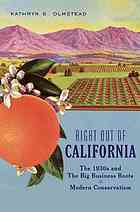
Right Out of California
The 1930s and the Big Business Roots of Modern Conservatism
کتاب های مرتبط
- اطلاعات
- نقد و بررسی
- دیدگاه کاربران
نقد و بررسی

July 13, 2015
Olmsted (Real Enemies), chair of the history department at the University of California, Davis, suggests that the New Deal’s National Industrial Recovery Act of 1933, which lacked protection for agricultural workers who wanted to unionize, served as the catalyst for the organization of the political right as it is known today. Olmsted’s research goes beyond newspaper archives and government transcripts, many of which, she points out, purposely did not record statements and speeches made by union organizers. Instead, she delves into oral histories and personal papers to tell the stories of how growers used violence, espionage, and virulent anti-Communist rhetoric to invoke the idea that unions would destroy the family, traditional gender roles, and whites’ ability to subjugate non-whites. Olmsted expressly places a larger focus on women’s involvement in the struggle for fair treatment of pickers, writing at length on Communist organizer Caroline Decker and political activist Ella Winter. This fuller perspective—along with sections on famous literary figures of the time, including Upton Sinclair, Langston Hughes, and John Steinbeck—cements Olmsted’s authority on the subject of labor organization. This is an accessible work that aids in contextualizing the rise of future conservative leaders such as Richard Nixon and Ronald Reagan. B&w photos.

July 15, 2015
A well-focused academic study of how the California agriculture business helped spur the conservative backlash against New Deal policies. Olmsted (Chair, History/Univ. of California, Davis; Real Enemies: Conspiracy Theories and American Democracy, World War I to 9/11, 2009, etc.) finds in Depression-era California the crucible for strong-arm policies against farm workers that bolstered the conservative movement. A key omission in the New Deal's early recovery programs for the faltering economy was protection of farm laborers for the same reason, the author notes, they were later excluded from the Social Security Act and the National Labor Relations Act: "powerful Southern Democrats wanted to maintain control over their tenant farmers and sharecroppers." In California, in particular, the agricultural leaders were both grateful for the subsidies offered by the Agricultural Adjustment Act and determined to bust the unions encouraged by the New Deal. In successive strikes across the state led by prominent communist union organizers like Pat Chambers and Caroline Decker in 1933, as the crops ripened in the fields, harvesters refused to work, hoping to raise wages. In response, the powerful growers would instigate all sorts of intimidation tactics and arrests, and they began to organize themselves-e.g., in the Associated Farmers, a group that "spread the word about the Communist threat." The agitation prompted bohemian writer sympathizers like John Steinbeck, Ella Winter, and Lincoln Steffens to alert a national audience to the strikers' cause in their work. One example was Steinbeck's In Dubious Battle (1936), although, curiously, he eliminated people of color and women to showcase only white men's struggles. Olmsted examines the federal response in the form of labor chief Frances Perkins' associate, Gen. Pelham Glassford, who was sent into the Imperial Valley to solve labor disputes, recognizing that "growers were no better than thugs." The author also discusses the rise of professional political consultants and leaders like Richard Nixon, who perfected the smear campaign. A work that knowledgeably situates the pioneering of a nasty new style of politics.
COPYRIGHT(2015) Kirkus Reviews, ALL RIGHTS RESERVED.

























دیدگاه کاربران